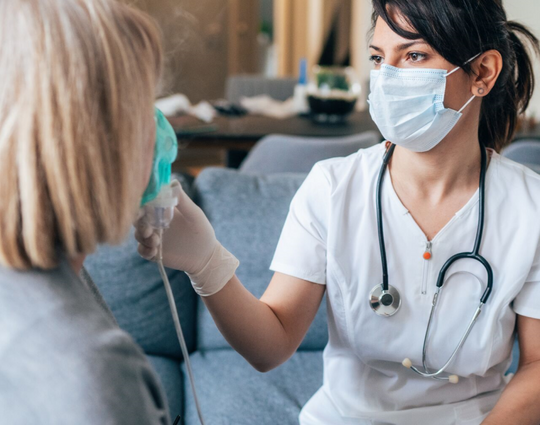
 The COVID-19 pandemic has spread throughout the globe and in the United States. As healthcare leaders, we must ensure every patient is given the best care regardless of their ZIP code.
The COVID-19 pandemic has spread throughout the globe and in the United States. As healthcare leaders, we must ensure every patient is given the best care regardless of their ZIP code.
The pandemic has exposed the fragile state of our healthcare system, specifically in underserved communities. This pandemic can impact the underserved communities more than others due to their financial and health disparities. Their lack of health insurance, accessible community health facilities, and feelings of isolation may compound their existing inequalities. The lack of action to address these vulnerable populations will make it nearly impossible to control the spread of COVID-19.
During this time, not only is it going to take personal commitment to beat the virus, but the use of technology as well. Technology can play a vital and active role by tracking virus statistics, helping discover where the testing gaps are located, inventory of resources, and identifying where telehealth is most needed during the shelter-in-place.
The industry is proud to support our healthcare providers fighting COVID-19 on the frontline; however, underserved communities are suffering. As changemakers, if we do not address the lack of access to credible, transparent and correct health information factors now, they will become more significant issues in the future.
A panel of thought leaders explores issues, including access to care and social determinants of health, being amplified by COVID-19 and how to change the narrative between health systems/providers and underserved communities.
COVID-19 has become the catalyst that intensified the existing fragile relationship between healthcare providers and the at-risk population. This mistrust is compounded by the information gap that exists in these communities. This gap prevents the population from receiving care specific to their needs. These needs include treatment for underlying medical conditions such as asthma, diabetes, heart disease, high blood pressure, and obesity. Those with chronic diseases in the underserved population must continue medical care as they have a higher chance of contracting COVID-19.
The underserved communities have had limited access to COVID-19 testing, which has been proven due to New Orleans, Milwaukee, Chicago, Detroit, District of Columbia, and Baltimore massive numbers in their inner cities. Documenting and informing the public of the country’s demographic analytics is a critical duty. Giving the underserved population power over their healthcare to fight COVID-19 may slow down the spread of the virus and save lives in the meantime.
We cannot focus on COVID-19’s impact without also referencing the elderly population that is getting hit the hardest by the virus. For those living in long-term nursing facilities where they are near other residents, and the facilities experience staffing shortages, poor infection control makes the underserved elderly population susceptible to the COVID-19. This susceptibility has shown positive tests or deaths in facilities in Washington State, Kansas, Oregon, Florida, Louisiana, Michigan, and Illinois.
The workforce in the long-term skill facilities is faced with challenges that include staff shortages, frequent turnovers, significant resident to staff ratio, not enough personal protective equipment (PPE), and, most importantly, lack of training and education for a large portion of the staff. Much of the staff who have direct contact with the residents are low-paying and living in poverty. Before COVID-19, they may have experienced socio-economic concerns; however, now it is compounded with the likelihood of getting the virus and, in turn, infecting their loved ones. Risking your life and those of your family is a heavy burden for poverty pay.
How Technology Can Help
Technology can help mitigate the impact of COVID-19 on the underserved population by implementing tools and resources. While many in poverty may not have a computer, despite this digital divide, the majority of those in underserved communities do have a smartphone, making digital channels a powerful means to send information to the masses.
Organizations have created websites for a resident to identify carriers of the disease, which has helped lead to a successful containment strategy. Other sites have been created, giving areas where testing is taking place in the resident’s city and state. Additionally, social media platforms are a means to send information to the masses, disseminate vital information about COVID-19, and provide a means for the underserved community population to obtain correct and quickly understood news.
A powerful platform that many providers and other healthcare facilities are turning to is telehealth. With our health system overburdened with sick COVID-19 patients, patients are not able to get seen for regular office visits or non-critical, same-day appointments. During COVID-19, the telehealth solution allows the residents to continue getting care for their chronic conditions. Telehealth can help ensure the underserved population’s chronic conditions do not decline during this pandemic. Discovering the value of technology, providers are expanding and upgrading services. For all of this to take place in the home, it allows the underserved community to obtain proper care without having to leave their home.
As we take a deep dive into the current environment and how it is affecting the impoverished, underserved, and minority communities, healthcare leaders, innovators, and changemakers have a responsibility to evaluate why we are here and what can we do now to reduce these challenges in the future, including:
- Investing in federally qualified health centers providing primary care services for underserved populations to give them access to care, and reduce the cost of healthcare for those unable to pay. If this prototype were in place now, our inner-city hotspots for COVID-19 may not exist.
- Collaborating with local agencies since they are more likely to have the ability to address needs immediately.
- Making sure churches and community leaders are involved in the healthcare crisis sooner rather than later, which is what happened with the COVID-19 crisis.
- Providing education on health disparities and the impact it has on the underserved population’s health and healthcare.
Importantly, we need to educate our providers about seeing a person and not a color. We are aware that unconscious bias is real, but as a healthcare worker, you must slow down and move your thinking from the primitive, reactive parts of the brain to a more reflective level mind. With determination, providers can understand the struggles of their patients’ communities and respect how different their way of life is. We must realize, different is not always bad. To do this, healthcare workers must actively work to have an interpersonal relationship with their patients. COVID-19 is a wake-up call for our nation, our healthcare industry and people.
The views and opinions expressed in this blog or by commenters are those of the author and do not necessarily reflect the official policy or position of HIMSS or its affiliates.
Global Health Equity Network
Help advance the cause of health and wellness for everyone, everywhere by advocating for underserved groups in health information and technology around the globe, and collaborate to find real-world solutions to challenges and roadblocks.
Originally published 13 April 2020; updated 2 June 2020



